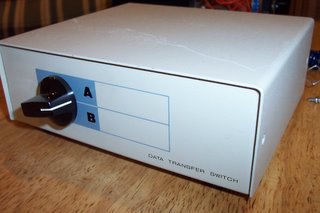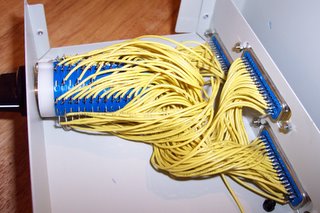 Procrastination has its price. As I finally decided to put up my projects online, I notice that there are others like myself, who like to save some money, and have their projects up and running. So, if I come across others that are the same as mine (or at least the same idea) I will post to their pages also.
Procrastination has its price. As I finally decided to put up my projects online, I notice that there are others like myself, who like to save some money, and have their projects up and running. So, if I come across others that are the same as mine (or at least the same idea) I will post to their pages also.
The DIY RCA Switch Box is not a new idea, (LifeHacker), just a little difficult to do. What you need to accomplish such a task is patients and time. You can always go and buy one, but if you need a certain configuration that might be expensive.
For mine, I needed 4 inputs to 1 output, and I didn't feel like spending more then $10. I found an old parallel printer A/B switch box, which was not being used (USB printers now), so I took it apart.
I found an old parallel printer A/B switch box, which was not being used (USB printers now), so I took it apart.
The first thing was that it was an A/B switch box and I needed an A/B/C/D switch box, well I got lucky. The key is in the switch itself. (more on that in a bit)
When you take it apart it might seem just a little overwhelming with all the wires, but in fact, it is really simple. You can either unsolder all the wires off or just cut them at the end NOT connected to switch.
You can either unsolder all the wires off or just cut them at the end NOT connected to switch.
I would recommend unsoldering off the switch end for easier testing of switch.
Now for the fun part:
Carefully take the switch apart. Now this part is hard to explain, the switches I had were A/B switches, but inside I flipped over the "how-many-positions" plastic piece and got what I wanted.
Now after we get the switch to the number of positions we need, its time for the task of figuring out how to set it up.
Because each application and switch are going to be different then mine, I will show how I did mine, and you can use that as a guide for yours.
All you have to do is get your trusty multi-tester with an ohm or continuity checker on it and start figuring your wiring diagram.
Here's a scan of mine.
 The color codes are for the switch positions. on the 4th position, I was only able to get mono because I broke one of the mini-contact points inside the switch.
The color codes are for the switch positions. on the 4th position, I was only able to get mono because I broke one of the mini-contact points inside the switch.
I don't know if you will be able to make heads or tails over my schematics, but maybe they'll help someone.
After you get the switch figured out, all you do is mount the connectors and solder the wires to them. I used the old A/B switch box as the new one, but I had to cover those huge holes where the parallel ports were. I used expansion card place holders. You know, those metal brackets you put in to cover the hole that's left from removing that unused modem out of your computer.
I used the old A/B switch box as the new one, but I had to cover those huge holes where the parallel ports were. I used expansion card place holders. You know, those metal brackets you put in to cover the hole that's left from removing that unused modem out of your computer.
That worked out well. Now my box is finished, except for the labeling on the front. I can connect my DVD, PS1, Camcorder, and for the mono jack, I got my computer plugged into that one. (s-video to composite cable).
I hope you can find this a help. Because you are in control of the wiring, you can make your own S-Video switch box, or DVI switch box, etc.
Just have fun
-=** UPDATE **=-
I have realized that my diagram is not easily interpreted, so I'll try to explain it.
First take a look at the picture of the actual switch. You will notice a lot of metal tabs sticking out. Those are the contact point to solder to. Now look at the diagram. You will notice that it is color coded. Those colors represent which contacts have continuity when in the corresponding switch position. There are three contacts per position. One for input and Two for output (A/B).
--For Example: Pins 4,5,6 have Blue and Green. ---Pin 4 connects with Pin 5 in switch position 1 --- Pin 6 connects with Pin 5 in switch position 2-- So you can have video-in on Pin 5 and video-out on pin 4 and 6.
The Yellow position didn't have any continuity to other pins, so I had to use another "disk". The switch I took apart was made up of several "disks". Yours might be different, so you'll just have to get out that trusty multi-meter to test the continuity of your disks.
If you have ANY questions, or I did not explain well enough, just send me and email at computerguru365 (at) gmail (dot) com. I will update as needed.
Tuesday, February 14, 2006
DIY RCA Switch Box **UPDATED**
Saturday, February 11, 2006
What to do with your unused flatbed scanner
You got yourself a brand new all-in-one scanner, printer, fax, copier machine, so what are you going to do with your old flatbed scanner. Well I will show you a couple of things you might just be brave enough to try, all with no or little cost, depending what you have lying around the house.
First we'll strip that scanner of the usefull things.
Taking the light out of the scanner and using it in your computer.
I'll start off by sayng that when I undertook this project I did not find anything online, but as I aquired another scanner to take step-by-step pictures for this how-to, I came across THIS link, which is simmilar to my project. I did take it one step futher. I also used the mirrors that were in there too. It quadrupled the light output.

I used silicone caulking to glue the mirrors together. To mount the light tube, I took the rubber mounting "shock absorbers" out of a old CD player. I wrapped the DC-AC tranformer with a piece of ide 40-pin cable and hot glue.
I added a rocker switch from a burned out power strip, and mounted inside my computer with some cable ties.
The Finished Product.
note: I have not noticed any temperature
increase with this light in my computer.
-=-=-=-=-=-=-=-=-=-=-=-=-=-=-=-=-=-=-=-=-=-=-=-=-=-=-=-=-=-=-=-=-=-=-=-
Here's a link that shows what to do with the scanner after it has been stripped clean of useful parts: Scanner computer case mod
I have not done this, but you could always just use the glass out of the scanner to mod your current case and put a nice window in it.
-=-=-=-=-=-=-=-=-=-=-=-=-=-=-=-=-=-=-=-=-=-=-=-=-=-=-=-=-=-=-=-=-=-=-=-
And finally the original idea for the use of the scanner light was for a ghetto flashlight, made entirely of materials I had around the house.
The Ghetto Flashlight
Items needed:
- 1 scanner light (optional mirror attachment)
- external modem case (or other project box)
- 9 v battery
- switch
- wires
- 1 old paint roller
- hot glue
 All you need to do is mount the electronics inside the modem case, hot glue the scanner light to a paint roller that has been cut in half lenghtwise. Then hot glue the roller to the modem case.
All you need to do is mount the electronics inside the modem case, hot glue the scanner light to a paint roller that has been cut in half lenghtwise. Then hot glue the roller to the modem case.The reason to use hot glue is that it does not conduct electricity, and it can come off cleanly. Mainly because I knew that this wasnt going to be permanent.

As you can see using the mirrors makes it look like you have 4 bulbs instead of just one. The picture below shows the flashlight on.

Please feel free to post your ideas for unused computer components. Even if they are just ideas, and have not yet been completed.
Tuesday, February 07, 2006
DIY Blackberry USB repair
 So you got a little rough with your Backberry and ripped out the USB port, what are you going to do? Some of us are in such a hurry, we forget to unplug the charging cable from our mobile device when we snatch it up to go somewhere. I will show you how to fix-it-yourself so you can spend your money on other things. This repair is for a Blackberry 7100t, and can be used for any mobile device.
So you got a little rough with your Backberry and ripped out the USB port, what are you going to do? Some of us are in such a hurry, we forget to unplug the charging cable from our mobile device when we snatch it up to go somewhere. I will show you how to fix-it-yourself so you can spend your money on other things. This repair is for a Blackberry 7100t, and can be used for any mobile device. First, you will need to find a replacement part. I had an old digital camera that I wasnt using. It had the perfect replacement USB port that I needed.
First, you will need to find a replacement part. I had an old digital camera that I wasnt using. It had the perfect replacement USB port that I needed.
Next we need to take apart the Blackberry. There are 4 screws: 2 at bottom under battery and 2 at top under speaker cover. Both are hex head but I just used a little flat head screwdriver.

Next we need to remove the 4 screws that are holding the black speaker/battery housing.
 Here is the Blackberry opened up, and the arrow is pointing to where we need to put the new USB port.
Here is the Blackberry opened up, and the arrow is pointing to where we need to put the new USB port.
Now we get to take apart our victim, the camera. Because there are many possibilities of where you get a replacement USB port, you wont need to follow the next step. You can just use it for reference.
Here is the location of the USB port inside the camera. Because I dont have a de-soldering iron, I just used my soldering iron and a can of compressed air to blow the melted solder away. NOTICE: I dont recommend using that tecnique on something you want to keep, because it blows the solder all over the place possibly shorting your valued electronics.

This is a close-up picture of the old USB port. Notice that there are some pins missing.
This is the new USB port. I had to bend the
mounting tabs to fit where the old port went.
Location of where the USB port goes.
This is my wonderful job of soldering. I basicly used the solder that was left on the PCB (green part) and just heated the pins with my soldering iron. The mounting tabs (the big blobs of solder) was a bit of overkill, but i didnt want it to pull out again.
Now put the Blackberry back together in reverse order of taking it apart.
FINISHED! And it works.
I hope this helps someone fix their own USB ports on whatever products they have like mp3 players, phones, psp, ipods, etc.
Welcome to the DIY Computers and Electronics Blog
This blog will be for posting and discussing computer/electronics do-it-yourself ideas and projects. For all those who enjoy building and modifiying electronics rather then buying the upgrade. Here you can post your projects and get feedback and help from others who like to do what you do - Build-it-yourself!
I have a few projects that I have completed and others that I am curently working on. I will post them to get feedback and help when I get stuck with a problem.
For now, I will open up feedback from anyone, so you dont have to be a member or submit a link to make a comment. In the future I will request others to post their projects so that others can help and comment on them.
If you are working on or have completed a project, but dont know how to post them, just take some pictures of it and email them to me at computerguru365 ( at ) gmail (dot) com.

